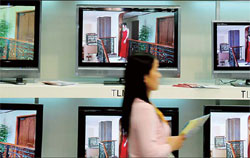Center
China on track for digitization
By Liu Baijia (China Daily)
Updated: 2007-03-29 08:46
 |
Large Medium Small |
Hisense digital TVs displayed at an exhibition in Beijing. |
At the opening of the 15th China Content Broadcasting Network (CCBN) exhibition, Zhang said yesterday the SARFT had formed six working groups in cooperation with several other ministries to implement the terrestrial digital broadcasting standard, which will take effect from August 1.
It's a major step in China's plan to provide digital broadcasting for the Beijing Olympic Games next summer.
"Digitization is and will remain the No 1 task for us," said Zhang. "We should use the hosting of the Games as a golden opportunity to accelerate that development and increase our core competence."
Digitization, which paves the way for more programs, interactive services and more commercial opportunities, has been on top of the SARFT's agenda since 2003.
At the most important annual policy briefing for the broadcasting industry, Zhang said China Central TV, the national broadcaster, will start terrestrial broadcasting of high-definition programs in October.
Commercial chips for mobile TV broadcasting are also ready, after China released another national standard on mobile TV broadcasting last year.
Du Baichuan, chief engineer of the SARFT, had earlier said China will provide digital TV, high-definition TV, mobile TV, and Internet protocol TV as scheduled before the Games kick off in seven host cities next year.
However, it may not be plain sailing for digitization, said Zeng Huiming, editor of Radio and Television Information magazine.
"Some related specifications for the terrestrial broadcasting standard have not come out yet and transmitters and receivers in compliance with that standard are not ready, so the real deployment will be a long process," said Zeng.
Over 360 million Chinese households have access to television and 140 million families have cable TV, but there are only 12 million digital TV users.
In spite of the obvious attractions of crisp picture and sound, people are somewhat reluctant to make the switch to digital TV because Chinese households usually get more than 30 satellite channels, and so don't want to pay more for similar programs.
Since 2004, the SARFT and other ministries have been promoting digitization to entire cities. So far, 49 cities have been chosen as trial locations, 25 of which have already persuaded almost all their residents to go digital.
Zhang also said the central government will spend 3 billion yuan this year and the next to take radio and TV programs to rural regions. For very remote regions, 3.4 billion yuan will be spent from 2006 to 2010 to bring them satellite radio and TV programs.
(China Daily 03/29/2007 page13)
| 分享按钮 |
